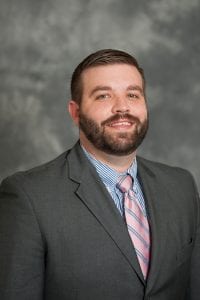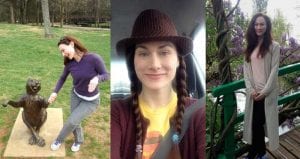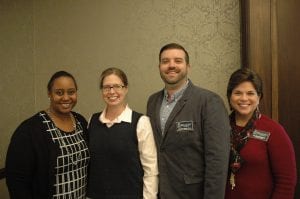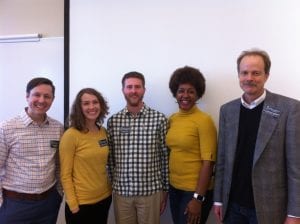Last fall, the Tea ching Center’s first Lunch Discussion focused on diverse perspectives for the classroom. Belmont faculty panelists (from left to right) , Edgar Diaz-Cruz (Pharmacy), Mona Ivey-Soto (Education), Linda Jones (Psychological Science), and Cheryl Slay Carr (Music Business) shared insights from their own pedagogies on methods for engaging racial, ethnic, gender, or other diversity themes in coursework through course creation, course design, and potential challenges along with successful practices. Drs. Ivey-Soto and Diaz-Cruz reflect below on these experiences.
ching Center’s first Lunch Discussion focused on diverse perspectives for the classroom. Belmont faculty panelists (from left to right) , Edgar Diaz-Cruz (Pharmacy), Mona Ivey-Soto (Education), Linda Jones (Psychological Science), and Cheryl Slay Carr (Music Business) shared insights from their own pedagogies on methods for engaging racial, ethnic, gender, or other diversity themes in coursework through course creation, course design, and potential challenges along with successful practices. Drs. Ivey-Soto and Diaz-Cruz reflect below on these experiences.
Courageous Conversations in the Classroom
Mona Ivey-Soto, Ph.D.
Assistant Professor of Education
Self-work is hard work! I find myself telling my students this throughout the semester in FYS, Education and Social Work classes. Critical conversations on the wide span of diversity issues that impact ourselves and others (including race, class, gender, religion, sexual orientation, gender, community, ability) requires us to engage in the deeply personal work of actively interrogating our biases and stereotypes and committing to anti-bias action both individual and within systems and structures. One of the frameworks that helps to situate this work and is a good starting place is the idea of cultural humility. Cultural humility is defined as “the ability to maintain an interpersonal stance that is other-oriented (or open to the other) in relation to aspects of cultural identity that are most important to the [person].” Our self-work therefore becomes deeply courageous rather than safe or predictable. Often times we think of cultivating a “safe space” within our classrooms and while I understand the notion of safety as an imperative element to building trust and empowerment, I believe that work that challenges oppression and injustice requires tremendous courage for our students and ourselves. With these ideas guiding me, my students and I must actively co-construct the conditions within our class for courage to flourish. How do I situate myself as a figure who holds knowledge and professionalism, but also as someone who can learn and collaborate with my students? How can my students make sure to be aware of their own social identities and how they may or may not privilege those identities over others even unintentionally? These are just a few of the questions circulating within our classroom as we do this important work.
Here’s a great example to bring these ideas to life. My students recently completed an in class exercise called “Building your Cultural Chest.” They were asked to bring in 5 items/symbols that help tell a story about some part of their identity (racial, cultural, community, gender, religious…). This simple sharing became a powerful moment of truth for many as they boldly discussed highly personal stories of addiction, mental health, family loss as well as fun moments of international travel and favorite family pets. The “diversity” within this activity allowed for a significant amount of self-learning and also classroom/community building. By just the second week of class we had created the conditions for courageous sharing and vulnerability. As the students concluded their sharing, I asked them to identify any strands or commonalities that they heard in each other’s stories. Many were excited to share travels around the world and proudly brought passports highlighting their knowledge of diverse cultures through international travel. While I celebrated these incredible, life changing experiences, I also used this as a moment to highlight the level of privilege that is necessary for that sort of travel. I reminded that that while we’re at a private institution and many enjoy the privileges and benefits afforded by wealth, it’s important to recognize our social class differences and not assume that one’s own identities and lived experiences are shared by all. Perspective taking, an essential tool of cultural humility, must be felt and named within a classroom where diverse narratives are shared.
Finally, as a higher education community, I believe we can invite courageous conversations into our spaces regularly and across disciplines. These conversations aren’t limited to certain professions or areas of study. We are all deeply committed to transformative education for all of our students and we want them to depart from our campus as critically engaged citizens ready and willing to advocate for social change. As a voice in their journey, we need to demonstrate not only our subject matter knowledge, but our passion for social justice in the classroom and the community.
Using Health Inequalities as a Way to Teach Diverse Perspectives in the Classroom
Edgar S. Diaz-Cruz, Ph.D.
Assistant Professor of Pharmacy
All people should be treated fairly and equally. Nondiscrimination and equality should be considered core values of the healthcare system. Although the health profile of Americans has improved over time, health inequalities still exist in certain population groups. When I first came to Belmont University, I dedicated most of my time and effort teaching students the latest advances in pharmaceutical care. However, I soon realized that unfortunately both the access and quality of healthcare among different population groups is not homogeneous. It soon became clear that social determinants of health such as income, education, unemployment, food insecurity, social exclusion, safe neighborhoods, among others are strong predictors of health outcomes. Human identity as dictated by race, ethnicity, culture, and gender dictates how these factors influence health. It is no surprise that the best way to close these gaps in health is to educate our future healthcare providers so that they become more aware of their own culture and biases so that they treat all patients equally. For this reason, I take the “social determinants educational approach” to include diverse perspectives in our classroom discussions.
In 2013, I proposed the development of a Health Disparities elective course to give students the opportunity to get a more in-depth understanding of the role of pharmacists in reducing health disparities in the United States. An anonymous survey conducted as part of this course showed that the majority of the students elect to take this course because they are interested in the topic and to gain a deeper understanding of the subject. Furthermore, these results showed a lack of knowledge and awareness in the subject in our student population. The United States Department of Health and Human Services expanded its nationwide health-promotion and disease-prevention goals by adding a “Social Determinants of Health” goal to its Healthy People 2020 overarching goals. I thought it was very fitting when our Belmont University Vision 2020 guiding principles mirrored that same initiative.
It took me some time to design a course that includes diverse perspectives and fosters objective critical thinking. I strive to create an environment of respect and openness in my classroom. Diverse perspectives are taught in the dimensions of race, ethnicity, culture, gender, sexual orientation, socio-economic status, age, and religious beliefs. Course topics are first introduced in lecture and discussed using objective primary literature. Video documentaries are used to supplement course lectures and become the basis and platform for multiple reflection papers. Diverse perspectives are also introduced in group discussions by using learning tools such as; a board game to build empathy with marginalized people and gain an awareness of the students’ own social location, in-class activities to explore their own personal biases, an immersion project to assist students relate research findings with real life situations, and invited guest speakers to learn from a first-person perspective.
My experience teaching diverse perspectives as part of my courses have been nothing but rewarding. It allows me and my students to explore our own culture, prejudices, and biases. It challenges us to get out of our comfort zones and get a clear picture of what is outside in the real world when we leave our classroom. It teaches students cultural sensitivity to better prepare them to engage in effective cross cultural communications. While it is hard for some students to discuss diversity issues, explore their own history and upbringing, understand different political ideologies and religious beliefs; it makes for a more realistic and complete education experience. In the end, it fills me with extreme pride and joy to know that students are more aware of their role as healthcare providers in reducing health disparities and that I have contributed to the development of more competent individuals that have the potential to become agents of change in our society.








